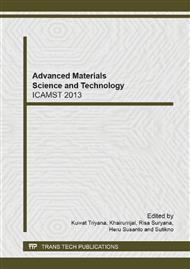p.574
p.578
p.582
p.586
p.591
p.596
p.600
p.605
p.609
Influence of Sintering Temperature on the Translucency of Sintered Zirconia by Cold Isostatic Pressing
Abstract:
Zirconia-based ceramics exhibit excellent mechanical properties and biocompatibility in dental applications. However, the production of translucent zirconia that offers resemblance to real teeth remains a challenge. This study aims to fabricate zirconia compacts by cold isostatic pressing (CIP) and investigate the influence of sintering temperature on translucency, microstructure, hardness, and density of yttria-stabilized tetragonal zirconia polycrystals (Y-TZP). Zirconia stabilized with 3 mol% yttria (3Y-TZP) was pressed by uniaxial pressing and later by CIP to produce green bodies in pellet form. Subsequently, the green bodies were sintered at different temperatures (1100 °C to 1300 °C). The specimens were then investigated in terms of translucency, density, and hardness. X-ray diffraction was also performed and the microstructure of the specimens was observed under a scanning electron microscope (SEM). Density and light transmittance tests results showed that zirconia sintered at 1200 °C exhibits the highest density (5.957 g/cm3) and light transmittance intensity. Vickers hardness test showed that higher sintering temperatures result in higher hardness of the sintered zirconia. SEM micrographs illustrate the effect of microstructural changes on the translucency of zirconia. A temperature of 1200 °C is found to be the recommended sintering temperature at which zirconia exhibiting optimum translucency and mechanical properties is produced. CIP is found to be a suitable consolidation method to produce high-density translucent zirconia.
Info:
Periodical:
Pages:
591-595
Citation:
Online since:
February 2014
Price:
Сopyright:
© 2014 Trans Tech Publications Ltd. All Rights Reserved
Share:
Citation:


